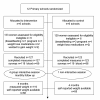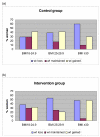Weight, physical activity and dietary behavior change in young mothers: short term results of the HeLP-her cluster randomized controlled trial
- PMID: 19409085
- PMCID: PMC2683875
- DOI: 10.1186/1475-2891-8-17
Weight, physical activity and dietary behavior change in young mothers: short term results of the HeLP-her cluster randomized controlled trial
Abstract
Background: Preventing weight gain rather than treating established obesity is an important economic and public health response to the rapidly increasing rates of obesity worldwide. Treatment of established obesity is complex and costly requiring multiple resources. Preventing weight gain potentially requires fewer resources to reach broad population groups, yet there is little evidence for successful interventions to prevent weight gain in the community. Women with children are an important target group because of high rates of weight gain and the potential to influence the health behaviors in family members.
Methods: The aim of this cluster randomized controlled trial was to evaluate the short term effect of a community-based self-management intervention to prevent weight gain. Two hundred and fifty mothers of young children (mean age 40 years +/- 4.5, BMI 27.9 kg/m2 +/- 5.6) were recruited from the community in Melbourne, Australia. The intervention group (n = 127) attended four interactive group sessions over 4 months, held in 12 local primary schools in 2006, and was compared to a group (n = 123) receiving a single, non-interactive, health education session. Data collection included self-reported weight (both groups), measured weight (intervention only), self-efficacy, dietary intake and physical activity.
Results: Mean measured weight decreased significantly in the intervention group (-0.78 kg 95% CI; -1.22 to -0.34, p < 0.001). Comparing groups using self-reported weight, both the intervention and comparison groups decreased weight, -0.75 kg (95% CI; -1.57 to 0.07, p = 0.07) and -0.72 kg (95% CI; -1.59 to 0.14 p = 0.10) respectively with no significant difference between groups (-0.03 kg, 95% CI; -1.32 to 1.26, p = 0.95). More women lost or maintained weight in the intervention group. The intervention group tended to have the greatest effect in those who were overweight at baseline and in those who weighed themselves regularly. Intervention women who rarely self-weighed gained weight (+0.07 kg) and regular self-weighers lost weight (-1.66 kg) a difference of -1.73 kg (95% CI; -3.35 to -0.11 p = 0.04). The intervention reported increased physical activity although the difference between groups did not reach significance. Both groups reported replacing high fat foods with low fat alternatives and self-efficacy deteriorated in the comparison group only.
Conclusion: Both a single health education session and interactive behavioral intervention will result in a similar weight loss in the short term, although more participants in the interactive intervention lost or maintained weight. There were small non-significant changes to physical activity and changes to fat intake specifically replacing high fat foods with low fat alternatives such as fruit and vegetables. Self-monitoring appears to enhance weight loss when part of an intervention.
Trial registration: ACTRN12608000110381.
Figures



Similar articles
-
Preventing weight gain: the baseline weight related behaviors and delivery of a randomized controlled intervention in community based women.BMC Public Health. 2009 Jan 3;9:2. doi: 10.1186/1471-2458-9-2. BMC Public Health. 2009. PMID: 19121220 Free PMC article. Clinical Trial.
-
The effect of weight management interventions that include a diet component on weight-related outcomes in pregnant and postpartum women: a systematic review protocol.JBI Database System Rev Implement Rep. 2015 Jan;13(1):88-98. doi: 10.11124/jbisrir-2015-1812. JBI Database System Rev Implement Rep. 2015. PMID: 26447010
-
A low intensity, community based lifestyle programme to prevent weight gain in women with young children: cluster randomised controlled trial.BMJ. 2010 Jul 13;341:c3215. doi: 10.1136/bmj.c3215. BMJ. 2010. PMID: 20627974 Free PMC article. Clinical Trial.
-
Offspring body size and metabolic profile - effects of lifestyle intervention in obese pregnant women.Dan Med J. 2014 Jul;61(7):B4893. Dan Med J. 2014. PMID: 25123127 Review.
-
Can a small-changes approach help address the obesity epidemic? A report of the Joint Task Force of the American Society for Nutrition, Institute of Food Technologists, and International Food Information Council.Am J Clin Nutr. 2009 Feb;89(2):477-84. doi: 10.3945/ajcn.2008.26566. Epub 2008 Dec 16. Am J Clin Nutr. 2009. PMID: 19088151 Review.
Cited by
-
Unmet social support for healthy behaviors among overweight and obese postpartum women: results from the Active Mothers Postpartum Study.J Womens Health (Larchmt). 2011 Nov;20(11):1677-85. doi: 10.1089/jwh.2010.2509. Epub 2011 Sep 14. J Womens Health (Larchmt). 2011. PMID: 21916619 Free PMC article. Clinical Trial.
-
The design of maternal centered life-style modification program for weight gain management during pregnancy - a study protocol.J Res Med Sci. 2013 Aug;18(8):683-7. J Res Med Sci. 2013. PMID: 24379844 Free PMC article.
-
Reach and effectiveness of a weight loss intervention in patients with prediabetes in Colorado.Prev Chronic Dis. 2010 Sep;7(5):A103. Epub 2010 Aug 15. Prev Chronic Dis. 2010. PMID: 20712930 Free PMC article.
-
Exploring Diet Quality between Urban and Rural Dwelling Women of Reproductive Age.Nutrients. 2017 Jun 8;9(6):586. doi: 10.3390/nu9060586. Nutrients. 2017. PMID: 28594351 Free PMC article.
-
A Review of Multiple Health Behavior Change Interventions for Primary Prevention.Am J Lifestyle Med. 2011 May;5(3):10.1177/1559827610391883. doi: 10.1177/1559827610391883. Am J Lifestyle Med. 2011. PMID: 24358034 Free PMC article.
References
-
- The Australian Diabetes Obesity and Lifestyle Study http://www.diabetes.com.au/pdf/AUSDIAB_Report_Final.pdf
Publication types
MeSH terms
Substances
LinkOut - more resources
Full Text Sources
Medical
Molecular Biology Databases

